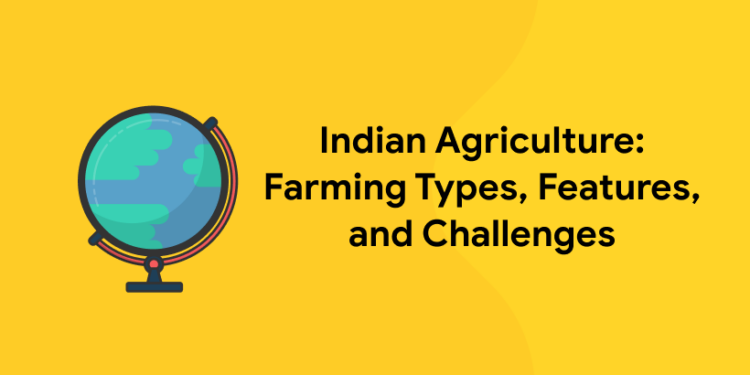Table of Contents
The Indian agricult8ure was the heart of the people’s living and the soul of the Indian economy. Around 58% of the people rely on agriculture for their living. Not only for consumption, agriculture sector is the primary sector of production which produces all the raw materials for the manufacture. The history of the Indian agriculture is the history of India as well as the history of the freedom struggle. Even after 75 years of impendence, there are not much changes happened to the sector. The Indian Agriculture sector is an important question pool area to be asked in any competitive examination. It is a major syllabus module in Kerala PSC KAS, Degree level Prelims and Mains and even for UPSC Civil Service Examination. Through this blog let us look comprehensively the Indian Agriculture its farming types, features and challenges.
Indian Agriculture: Farming Types
Agriculture as a practice depends upon various factors. These factors include the land available, the climate benefited, the irrigation needed, the labour facilitated etc. After considering all these factors the agriculture practice will be determined. Along with that the tradition of the farmers will also include while they practice agriculture. the objective of the agriculture will also include while determining the agricultural practice. Based on the factors the Farming types are classified as the following types:
- Subsistence Farming
- Commercial farming
Click Here to Enroll To Entri App for General Awareness and Latest Updates for Examinations
Subsistence Farming
1: Who was the first woman President of India?
This type of farming is done in order to meet the needs of the farming family only. There will be no surplus generated through this kind of farming. This is characterised by the use of low levels of technology and high amount of labour to yield output. The subsistence farming is characterised into two:
- Primitive Subsistence Farming
- Intensive Subsistence Farming
Primitive Subsistence Farming
It is practiced in the few pockets of India. the major characteristics of this farming is the use of primitive tools like hoe, dao and digging sticks on small patches of the land. This type of farming depends largely on the monsoon and other climatic condition and the natural fertility of the soil. This type of farming includes:
- Shifting cultivation
- Normadic Herding
Click Here to Enroll To Entri App for General Awareness and Latest Updates for Examinations
Shifting cultivation
Shifting cultivation is also called the slash and burn cultivation. A plot of land from the forest is converted into the cultivating land by cutting trees and burning them into ashes. Fertilisers are mixed with the ashes to cultivate the land. The cultivation is continued till the soil has fertility. After loosing the fertility of the soil, they shift to other land for doing the same. This practice has been seen extensively in Amazon basin, tropical Africa, parts of southeast Asia and Northeast India since these places receive the high rainfall and quick possibility of regeneration of vegetation.
Click Here to Enroll To Entri App for General Awareness and Latest Updates for Examinations
The slash and burn techniques have been called by different names in so many countries and areas:
| Slash and Burn technique alternate name | Country/ state in India |
| Milpa | Mexico and Central America |
| Conuco | Venzuela |
| Roca | Brazil |
| Masole | Central Africa |
| Ladang | Indonesia |
| Ray | Vietnam |
| Bewar or Dahiya | Madhya Pradesh |
| Podu or Penda | Andhra Pradesh |
| Pama Dabi, Koman or Bringa | Odisha |
| Kumari | Western Ghats |
| Valre or Waltre | South-eastern Rajasthan |
| Khil | Himalayan belt, |
| Kuruwa | Jharkhand |
| Jhumming | North-eastern region. |
Click Here to Enroll To Entri App for General Awareness and Latest Updates for Examinations
Normadic Herding
In this type of farming the herdman travels from one place to another with their animals for fodder and water along the definite routes. This type of movement is just to overcome the climatic and terrain constraints of the animals. The animals include sheep, camel, yak and goats. They usually rear it for milk, meat, wool, hides and other products. This type of farming is practiced in semi-arid and arid regions of Sahara, Central Asia and some parts of India, like Rajasthan and Jammu and Kashmir.
Intensive Subsistence Farming
This type of farming is done in areas of high population and less land are available. This farming is characterised by high amount of labour and high amount of irrigation and biochemical inputs to obtain high amount of output. One of the reasons for obtaining high amount of output from the land is because of the right of inheritance divided the piece of land available for cultivation. Due to the lack of other source of livelihood and non-availability of land forced the farmers ot obtain large amount of output from the land.
Free UPSKILLING Courses!
Take your first step toward mastering in-demand skills, acing interviews, and securing top-tier jobs with Entri's free upskilling courses.
Start Learning!Commercial Framing
In commercial farming the cultivation is for commercial purposes rather than the consumption purposes. In this type of farming, foods are grown and animals are reared for the purpose of sale in market. Extensive amount of capital, machines, and labour are used in the commercial farming. Use of high yielding variety seeds, chemical fertilizers, insecticides, pesticides are the characteristics of this farming. The commercial farming is further classified into the following types:
- Commercial Grain Farming
- Commercial mixed farming
- Plantations
Commercial grain farming
In this type of farming, food grains are cultivated for the purpose of sale in market. What would be a commercial food grain depends upon the land which it cultivates. Rice is a commercial crop in Punjab and Haryana because they don’t consume it. at the same it rice is a subsistence crop in Odisha where they largely consume rice. So, the degree of commercialisation of agriculture varies from region to region.
Click Here to Enroll To Entri App for General Awareness and Latest Updates for Examinations
Commercial Mixed Farming
In this type of farming, the land is used for food and fodder crops and also for rearing the livestock. Two types of agriculture is done in same time using the same land itself called mixed farming. It is largely practiced around the world especially in areas like Europe, eastern USA, Argentina, southeast Australia, New Zealand and South Africa.
Plantations
Plantations simply the practice of cultivating a single crop over the large area of land. The crops include tea, coffee, sugarcane, cashew, rubber, banana or cotton etc. A transport nexus nearby is needed for the effective practice of plantation. The produce may be processed in the farm itself or in the factories nearby.
Conclusion
The types of farming and its features are essential factual background as well as conceptual clarity needed to better answering in competitive examination. the farming types may be reverified from your locality. As time and circumstances changes new types of farming can adopted and as well as the conventional types of farming can be avoided. Go through the above points and for more details and explanation enroll to Entri App and grab a course. Study with Entri and conquer heights. Keep studying keep winning












